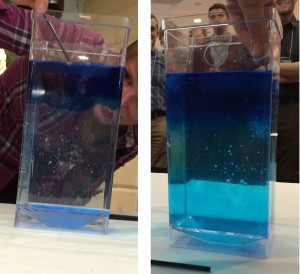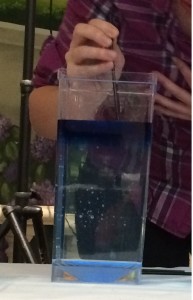
I failed… I deserve the cone of shame (original source: movie Up)
Last week, I was invited to the Forum for Arctic Modelling and Observing Systems (FAMOS) meeting in order to present an outreach demonstration. Since the Arctic Ocean and its changes are mostly controlled by buoyancy, my “what is buoyancy” demo was particularly relevant. It was a demo that I had done over the last years and was comfortable with. In July, when the organiser asked if I could extend it to include my particular topic of interest, deep water formation, I happily accepted. In retrospect, I should have thought twice about this.
1. Be prepared!
The demo set-up sounds easy enough: two layers of water of roughly the same density in a tank. The one at the bottom is basic tap water with a bit of salt in; the one at the top forms by melting ice cubes containing some easily visible food dye. As the ice melts, the layers remain separated. Although the water column looks stable, by blowing gently on the top with a straw, you create a downward movement of the top blue layer.
Having the experiment work at home, when I was relaxed and decided to practice just because I had nothing more urgent to do was not enough. On the actual day, I was tired and jetlagged (I had flown from Europe to the US the day before). I was also stressed because I did not know the equipment, and slightly intimated by the wall of 50+ people standing in front of me. The only way to perform well would have been to know the experiment by heart:
– how many drops of food dye per ice cube?
– how much salt per liter of water do I need?
– how long after I have stirred the water can I put the ice cubes in?
– how many ice cubes needed to have a layer of the correct thickness depending on the tank area?
– how long does it take to melt the ice cubes for various water temperatures?
In my case in particular, I did not know what the water tank dimensions would be until I arrived on site. And honestly, I was not prepared enough. I did my set-up “roughly” by eye, and ended up putting too much salt in the bottom water layer.
2. Expect the unexpected
Even if you are very well prepared, accidents happen! When I was practicing at home, the hardest part was actually keeping the two layers separated – they always wanted to mix as I was setting up the demo. On the actual day, I had the opposite problem: the layers did not want to mix anymore. With too much salt in the bottom layer, my water column was very stable, i.e the bottom layer was much denser than the top layer. The top layer had no reason to ever sink. I was prepared for the layers to mix (too) quickly, but suddenly I had to improvise!
Luckily, my audience was a group of scientists who were interested in making the experiment work, so it turned into an hands-on group activity!

Two possible alternatives suggested by the audience: shake more (left) or drop some salt in (right). Thanks to Sunke for taking the pictures
3. Turn your failure into a new experiment
Obviously, I was not very happy when I noticed that the demo was not working. But a week later, I realised that it was actually a great opportunity! Even the meeting organiser jokingly said so.
What to do then if you are failing your demo? First, keep smiling, and don’t try to fool people into thinking that the demo is working. No, it is not. Find an elegant, possibly humorous way to get out of this situation. For my demo, something like “ah, sorry, there was too much rain over the Atlantic this morning, the top of the ocean is too stable” could work, and then lead to explanations as to what makes the water column stable or unstable.
And then, ask your audience how to make the experience work. Not only it allows you to check that your explanations were clear, but it also is really fun! Senior professors got very excited when I gave them a bit of salt to try and make the surface waters sink! It also got the participants quite intrigued: a dozen or so people kept thinking about it and came back to me in the following days with further ideas of how to make it work.
So to summarise, failing my experiment was slightly embarrassing, but it was not such a dramatic event. My main advice if it happens to you would be that once it is over, reflect on what went wrong, and how you can improve your demo for next time.
And maybe write a SciSnack about it!








